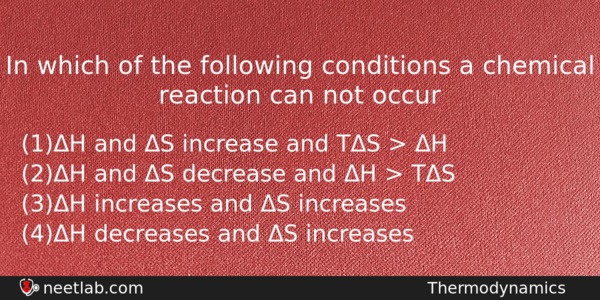| ⇦ | 
| ⇨ |
In which of the following conditions a chemical reaction can not occur
Options
(a) ΔH and ΔS increase and TΔS > ΔH
(b) ΔH and ΔS decrease and ΔH > TΔS
(c) ΔH increases and ΔS increases
(d) ΔH decreases and ΔS increases
Correct Answer:
ΔH increases and ΔS increases
Explanation:
(i)When ΔH and ΔS increase, then , if TΔS > ΔH the reaction is spontaneous.
Therefore ΔG = ΔH – TΔS = -ve.
(ii)When ΔH and ΔS decrease,then if ΔH > TΔS. This makes ΔG is -ve and process is spontaneous.
(iii) If , ΔH increases and ΔS decreases, then ΔG is +ve and process is non-spontaneous.
(iv) If ΔH decrease and ΔS increases, then ΔG is -ve and process is spontaneous.
Related Questions: - Which does not exist
- Gasoline has composition
- Which of the following exists as zwitter ion
- The catalyst used in Ziegler process for polythylene manufacture
- Two possible stereo-structures of CH₃CHOHCOOH, Which are optically active are called
Topics: Thermodynamics
(179)
Subject: Chemistry
(2512)
Important MCQs Based on Medical Entrance Examinations To Improve Your NEET Score
- Which does not exist
- Gasoline has composition
- Which of the following exists as zwitter ion
- The catalyst used in Ziegler process for polythylene manufacture
- Two possible stereo-structures of CH₃CHOHCOOH, Which are optically active are called
Topics: Thermodynamics (179)
Subject: Chemistry (2512)
Important MCQs Based on Medical Entrance Examinations To Improve Your NEET Score
18000+ students are using NEETLab to improve their score. What about you?
Solve Previous Year MCQs, Mock Tests, Topicwise Practice Tests, Identify Weak Topics, Formula Flash cards and much more is available in NEETLab Android App to improve your NEET score.
Share this page with your friends

Leave a Reply